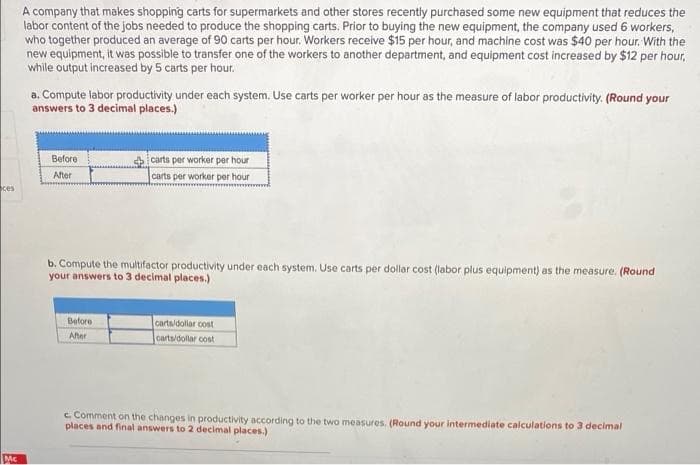A company that makes shopping carts for supermarkets and other stores recently purchased some new equipment that reduces the labor content of the jobs needed to produce the shopping carts. Prior to buying the new equipment, the company used 6 workers, who together produced an average of 90 carts per hour. Workers receive $15 per hour, and machine cost was $40 per hour. With the new equipment, it was possible to transfer one of the workers to another department, and equipment cost increased by $12 per hour, while output increased by 5 carts per hour. a, Compute labor productivity under each system, Use carts per worker per hour as the measure of labor productivity. (Round your answers to 3 decimal places.) Before carts per worker per hour Ater carts per worker per hour ces b. Compute the multifactor productivity under each system. Use carts per dollar cost (labor plus equipment) as the measure. (Round your answers to 3 decimal places.) Before carts/dollar cost Ater carte/dollar cost C. Comment on the changes in productivity according to the two measures. (Round your intermediate calculations to 3 decimal places and final answers to 2 decimal places.)
A company that makes shopping carts for supermarkets and other stores recently purchased some new equipment that reduces the labor content of the jobs needed to produce the shopping carts. Prior to buying the new equipment, the company used 6 workers, who together produced an average of 90 carts per hour. Workers receive $15 per hour, and machine cost was $40 per hour. With the new equipment, it was possible to transfer one of the workers to another department, and equipment cost increased by $12 per hour, while output increased by 5 carts per hour. a, Compute labor productivity under each system, Use carts per worker per hour as the measure of labor productivity. (Round your answers to 3 decimal places.) Before carts per worker per hour Ater carts per worker per hour ces b. Compute the multifactor productivity under each system. Use carts per dollar cost (labor plus equipment) as the measure. (Round your answers to 3 decimal places.) Before carts/dollar cost Ater carte/dollar cost C. Comment on the changes in productivity according to the two measures. (Round your intermediate calculations to 3 decimal places and final answers to 2 decimal places.)
Chapter1: Making Economics Decisions
Section: Chapter Questions
Problem 1QTC
Related questions
Question

Transcribed Image Text:A company that makes shopping carts for supermarkets and other stores recently purchased some new equipment that reduces the
labor content of the jobs needed to produce the shopping carts. Prior to buying the new equipment, the company used 6 workers,
who together produced an average of 90 carts per hour. Workers receive $15 per hour, and machine cost was $40 per hour. With the
new equipment, it was possible to transfer one of the workers to another department, and equipment cost increased by $12 per hour,
while output increased by 5 carts per hour.
a. Compute labor productivity under each system. Use carts per worker per hour as the measure of labor productivity. (Round your
answers to 3 decimal places.)
Before
i carts per worker per hour
After
carts per worker per hour
ces
b. Compute the multifactor productivity under each system. Use carts per dollar cost (labor plus equipment) as the measure. (Round
your answers to 3 decimal places.)
Before
carts/dollar cost
After
carts/dollar cost
c. Comment on the changes in productivity according to the two measures. (Round your intermediate calculations to 3 decimal
places and final answers to 2 decimal places.)
Mc

Transcribed Image Text:c. Comment on the changes in productivity according to the two measures. (Round your intermediate calculations to 3 decimal
places and final answers to 2 decimal places.)
Labor productivity
by
by
Multifactor productivity
Expert Solution
This question has been solved!
Explore an expertly crafted, step-by-step solution for a thorough understanding of key concepts.
This is a popular solution!
Trending now
This is a popular solution!
Step by step
Solved in 4 steps

Knowledge Booster
Learn more about
Need a deep-dive on the concept behind this application? Look no further. Learn more about this topic, economics and related others by exploring similar questions and additional content below.Recommended textbooks for you


Principles of Economics (12th Edition)
Economics
ISBN:
9780134078779
Author:
Karl E. Case, Ray C. Fair, Sharon E. Oster
Publisher:
PEARSON

Engineering Economy (17th Edition)
Economics
ISBN:
9780134870069
Author:
William G. Sullivan, Elin M. Wicks, C. Patrick Koelling
Publisher:
PEARSON


Principles of Economics (12th Edition)
Economics
ISBN:
9780134078779
Author:
Karl E. Case, Ray C. Fair, Sharon E. Oster
Publisher:
PEARSON

Engineering Economy (17th Edition)
Economics
ISBN:
9780134870069
Author:
William G. Sullivan, Elin M. Wicks, C. Patrick Koelling
Publisher:
PEARSON

Principles of Economics (MindTap Course List)
Economics
ISBN:
9781305585126
Author:
N. Gregory Mankiw
Publisher:
Cengage Learning

Managerial Economics: A Problem Solving Approach
Economics
ISBN:
9781337106665
Author:
Luke M. Froeb, Brian T. McCann, Michael R. Ward, Mike Shor
Publisher:
Cengage Learning

Managerial Economics & Business Strategy (Mcgraw-…
Economics
ISBN:
9781259290619
Author:
Michael Baye, Jeff Prince
Publisher:
McGraw-Hill Education